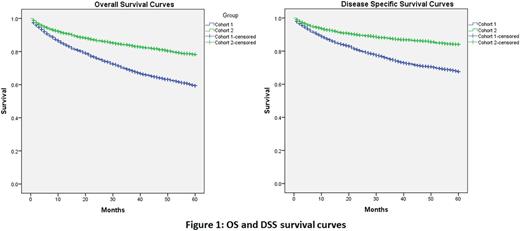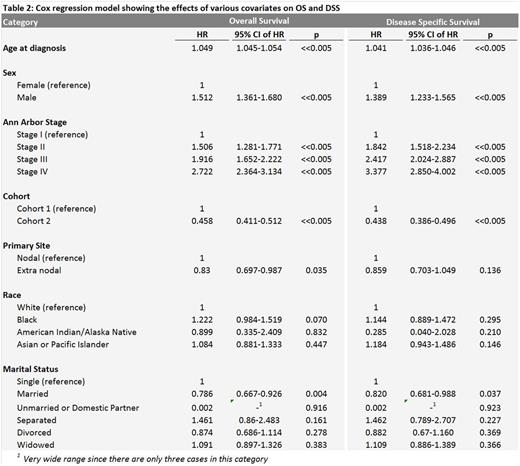Abstract
Background
Follicular lymphoma (FL) is the most common form of indolent lymphoma, however Grade 3 FL (FL3) has more aggressive behavior and its response to therapy is controversial. Several studies have reported improved clinical outcomes in patients with FL3 treated with rituximab (R), approved in early 2006, as a first line therapy for diffuse large B-cell lymphoma. The aim of this population based study is to compare the overall survival and disease specific survival in patients diagnosed with FL3 prior to and after 2006.
Materials and methods
We used the Surveillance, Epidemiology, and End Results 18 database to identify cases diagnosed with FL3 between 1983 and 2013, limiting the selection to patients aged more than 15 years with single primary malignancy. The data was split into two cohorts - Cohort 1 comprised of cases diagnosed between 1983 and 2005, with a study cutoff of December 2005, and Cohort 2 comprised of cases diagnosed between 2006 and 2013. The Overall Survival (OS) and Disease Specific Survival (DSS) for the two cohorts were calculated using the Kaplan-Meier method and the results were compared using the Log Rank test. The Cox proportional hazards regression model was used to identify factors other than time of diagnosis, which had a significant impact on survival times.
Results
Cohort 1 included 3,959 cases with death occurring in 1,319 cases during the study period (1,013 deaths due to disease specific factors) and Cohort 2 included 3,050 cases with death occurring in 509 cases (374 deaths due to disease specific factors) (table 1). The 5-year OS and DSS survivals for Cohort 1 were 59.3% and 67.7%, and for Cohort 2 were 78.3% and 84% respectively (figure 1). The differences in both OS and DSS survival rates were confirmed to be significant using the Log Rank test (p<<0.005 in both instances).
Cox regression analysis was performed using age at diagnosis, sex, race, marital status, primary site (nodal/extra nodal) and Ann Arbor stage as covariates, after removing cases with missing values. The test results showed that age at diagnosis, sex, Ann Arbor stage (p<<0.005 for all three) and primary site (p<0.05) had a significant impact on OS. However, DSS was not significantly influenced by primary site. Males had an increased risk of mortality, as did an increase in age and advanced Ann Arbor stage (table 2).
Conclusion
A significant increase in OS and DSS was observed in patients diagnosed with FL3 after the introduction of rituximab. Survival outcomes were also influenced by age at diagnosis, sex and Ann Arbor stage.
No relevant conflicts of interest to declare.
Author notes
Asterisk with author names denotes non-ASH members.




